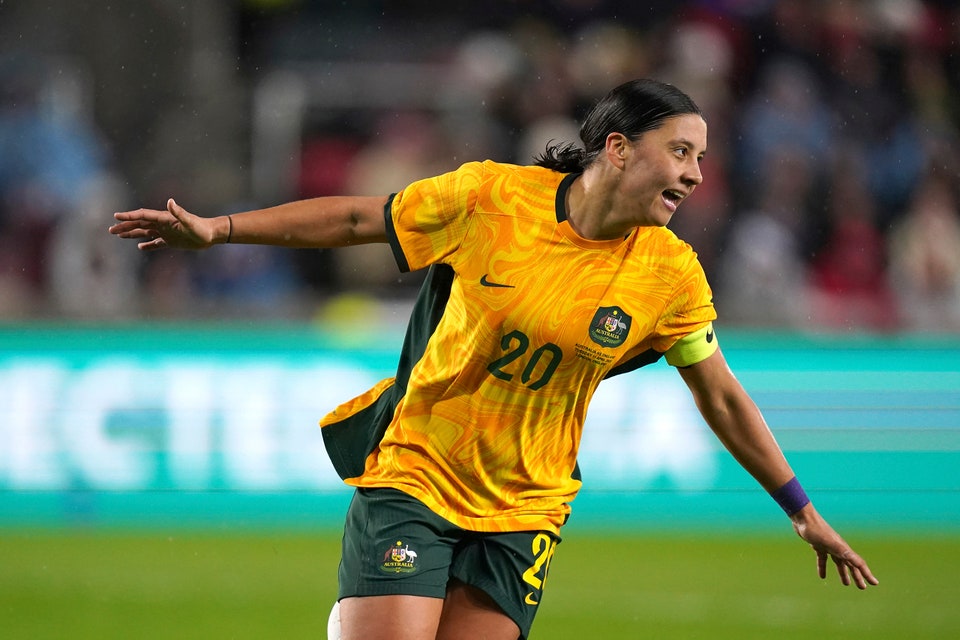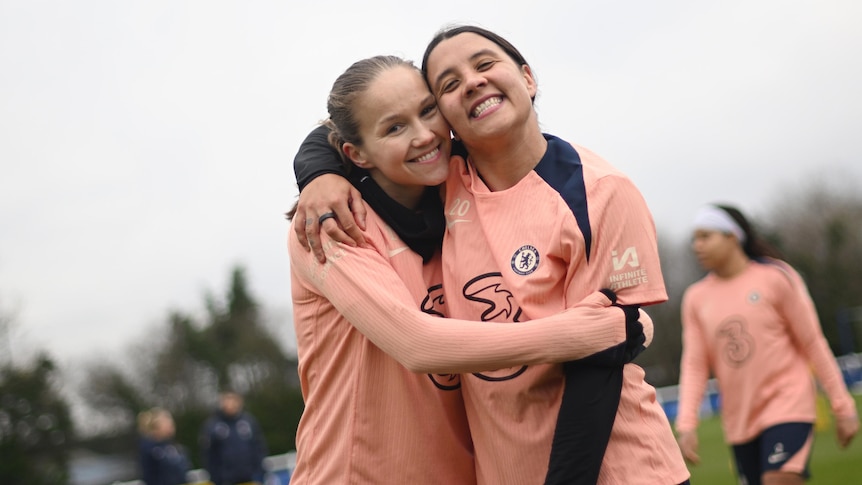Last winter, on a cold pitch in London, Liverpool’s women’s team played Chelsea, which was on a seventeen-game unbeaten streak and has lately been one of the dominant teams in English women’s soccer. It was the fourth round of the F.A. Cup, a knockout competition known for the occasional surprise. Liverpool scored twice—but Chelsea had Samantha Kerr. In the thirty-second minute, the twenty-nine-year-old striker received a pass from her teammate Niamh Charles, mid-run, raised a foot near the height of her shoulder, and pummelled the ball left to right into the top corner of the goal. Shortly after halftime, she scored again, off a quick pass, after stepping into a blind spot behind a Liverpool defender. Later, the ball came her way in the air. She jumped, the neck muscles turned, the ball fell in. When the game ended, the score was Liverpool 2, Kerr 3. “It was almost a given, wasn’t it?” a commentator murmured, before it was through.
Afterward, Kerr hugged her teammates and exchanged the customary back pats. Game-changing goals are routine for her—they seem to define the entire season for others. Like all of soccer’s great strikers, Kerr has a full menu of ways to score; commentators like to call it a knack, or an eye for goal. But, with Kerr, it’s all about motion. “Next time you watch her play, see who makes the first movements,” Emma Hayes, her coach at Chelsea, once said. “It’s always Sam.” Carli Lloyd, a two-time World Cup winner with the U.S. team, told me, “She’s a sniper in front of the goal. She will hover, and she will find a way.” Between 2017 and 2022, Kerr was the top scorer in every league she played in, across the highest tiers of Australia, the United States, and England—sometimes simultaneously. It has been nearly four years since she last played a game in the National Women’s Soccer League, in the U.S., but she is still the league’s all-time top scorer, with more goals than Alex Morgan or Megan Rapinoe.
Kerr is also the captain and star player of the national team of Australia, which, along with New Zealand, is hosting the Women’s World Cup. Australia has never advanced further than the quarterfinals. The reigning champion and world No. 1 is the United States. Spain has the best player in the world, the midfielder Alexia Putellas. England won the Euros, and Canada won the gold medal in the Olympics, where Australia finished fourth. Still, in the past few months, the Australian team, known as the Matildas, has beaten or matched several of the world’s best squads. Its second-best player, the defender Ellie Carpenter, is back from a nearly yearlong injury. And there will be a home-field advantage. “I think there’s tremendous pressure,” Lloyd, who will cover this year’s tournament as an analyst for Fox Sports, told me. “If they don’t go far in this World Cup, it’s going to be deemed as a failure.”
Under the direction of their coach, Tony Gustavsson, a tall, militantly optimistic Swede, the Matildas play a fast and aggressive style that can tread the line between dominance and disaster. (Gustavsson’s instructions before a match in Melbourne last year were, “Be true to who we are: Attack. Attack again. And attack again.”) Kerr is the team’s sharp edge. Last year, in a match at the Asian Cup—where Australia was a heavy favorite—she missed an easy chance, and Australia was knocked out. She said later, “I put a lot of blame on myself.”
“Sam always plays with that weight of the world on her shoulders,” Lloyd told me. Now the world will be watching. If, in front of a home crowd, a talented Australian team goes further than ever, it is almost a logical guarantee that Kerr will be key. To many Australians, she seems cosmically set to be the tournament’s defining player. “I love pressure,” Kerr told reporters two weeks ago. “I love being in a moment where one or two moments can change the path of your career, and this World Cup is one of those.”
Soccer in Australia has often been a marginal sport, the game for the immigrant or the young girl. One of the best-known Australian histories of the game, written by Johnny Warren, a former captain of the men’s team, has the ironically intended title “Sheilas, Wogs, and Poofters”—a trio of Australian slurs for, respectively, women, southern-European immigrants, and gay men, the three groups thought to make up soccer’s constituency. Warren, a sixth-generation white Australian, describes the story of Australian soccer as “a story of discrimination.” “My mates were petrified by football,” he writes. “It was foreign and it was often played by people who spoke a different language and ate different food.”
Kerr was born in Perth, in Western Australia, and grew up playing Australian Rules, a phenomenally entertaining sport, played on a huge cricket pitch, in which people tackle like in rugby, launch themselves in balletic jumps, and clamber on one another’s shoulders to catch the ball. Goals are scored with enormous punts. Kerr’s father and her older brother both played professionally, and Kerr played until she was twelve—she stopped only because there weren’t enough women’s teams. A.F.L. is dominant in the west and southeast of Australia, but less popular in the northeast, and not really played anywhere else in the world. Switching to soccer was like having “the rug ripped out underneath me,” she has said.



